How to Glimpse the Ancient Aztec Empire In Modern Mexico City
Mexico City is one of the largest urban centers in the world covering 573 square miles in the Valley of Mexico. Today's bustling metropolis geologically began as a terminal or closed lake basin. Water flowed into a system of lakes via the surrounding mountains but was not able to leave by way of rivers or permeable underground rocks to larger bodies of water like the ocean. Thus, evaporation being the only escape caused seasonal falling rains to converge into swamps and lakes in the valley basin below.
According to native legend, in 1250 C.E., a nomadic tribe known as the Mexica entered the Basin of Mexico searching for fertile valley land. The local Culhuacan people allowed the tribe to settle on a piece of land and in return, the Mexica would assist in battle. A daughter of the Culhuacan king was appointed to rule over the Mexica. She was sacrificed and the Mexica were driven from the land into Lake Texcoco, where an eagle perched on a nopal cactus was spotted on an island in the middle of the lake. On that island in 1325, one of the oldest capital cities in the Americas was born, Tenochtitlan (teh-nohch-tit-lan) or present-day Mexico City. Here the Mexica later named the Aztecs by the Spanish, constructed a mighty Mesoamerican empire stretching 80,000 square miles from the Pacific to the Gulf of Mexico and reaching as far south as Guatemala. Nearly 25 million people were subjects of Aztec rule. Taxation, manual labor, and human sacrifice would be the successful engineering of a grand floating city and the demise of a brutal empire.

An idealized image of Tenochtitlan in a large scale fresco by Diego Rivera in the Palacio Nacional in Mexico City, painted in 1941-1952, photo by J.Trandell.

A modern view of the central plaza of Tenochtitlan, photo by C. Jones.
The Cathedral of Mexico (left) sits atop an ancient Aztec Temple, Templo Mayor. The National Palace (background) is built on top of the palace of Moctezuma II, the ruler of the Mexica during the arrival of the Spanish. The Mexican Presidential offices and treasury currently reside in the Palacio Nacional, as well as, 11 large scale frescoes depicting the History of Mexico as painted by the Mexican muralist Diego Rivera.
Both mountains and volcanoes surround the Valley of Mexico. Volcanic rocks are less dense and lighter weight construction material. Life in the middle of a lake presented challenges like subsidence or sinking foundations. The early Mexica inhabitants engineered 30 feet long by 4 inch wide wooden piers to be inserted into the stable earth beneath the shallow lake bed. Masons then built upon the stabilized foundation piers massive temples and other structures with light-weight volcanic rock cemented together with limestone plaster.

Behind the Cathedral is an ongoing excavation of the Great Pyramid of Tenochtitlan. The entrance fee includes the Templo Mayor Museum and the archaeological site.
In 1978 a local power company digging a trench near the Palacio Nacional unearthed a massive stone carving that lead to the eventual discovery of the great Tenochtitlan pyramid, Templo Mayor. The volcanic rock and limestone plaster used to construct the temple remains intact nearly 600 years later. Like the Spanish conquerors who constructed a new city atop the Aztec buildings, so did the Mexica build upon the older structures as the empire expanded. The Templo Mayor was constructed during the zenith of the empire in the late 15th century. The base of the pyramid is believed to be 240 ft x 300 ft and 15 stories high. To complete the great temple would have required a massive amount of manpower and plenty of human sacrifice.

Unearthed stairs at the Templo Mayor archaeological site in Mexico City.
Archaeologists have determined through historical and empirical data that the empires of Central America did not have beasts of burden or the use of the wheel. Heavy rocks and lumber were carried by men across mountains and deserts. In the formation of the island city of Tenochtitlan, canoes carried goods and freshwater to the early inhabitants. Eventually, the building of grand temples and other massive structures required other means for resources to reach the island. Miles of wide causeways, aqueducts, and levees were engineered creating a sophisticated ancient city. As the empire grew through military expansion, men, women, and children were seized or traded from the newly acquired provinces. Tens of thousands of men were needed for building construction and as military soldiers. Women, children, as wells as, men were used in ritual human sacrifice. During the excavation of the Templo Mayor, a great wall of human skulls was unearthed confirming native legends of the Mexica's thirst for blood.
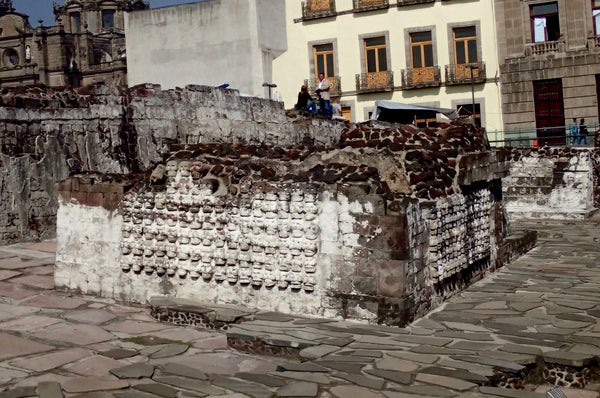
Wall of skulls in situ (above) and a wall of unearthed skulls on display inside the museum (below.)
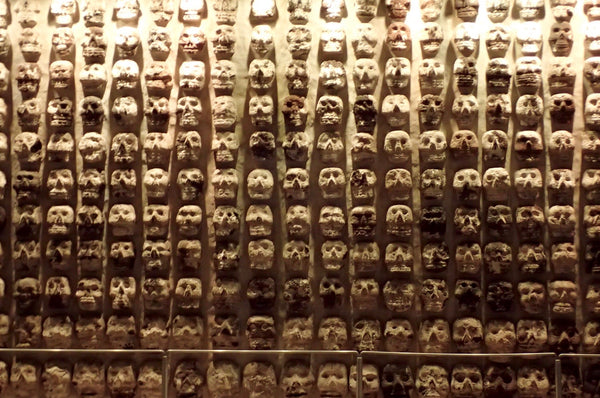
As the population of the island city grew, so did the need for food. Artificial floating gardens or chinampas were utilized in the shallower lakes to the southwest of the capital. Agricultural floating islands were created from woven reeds and piled with mud and earth. Organic matter from the vegetation and moisture from the lake provided an intensive and highly productive form of farming. Fruits, vegetables, and other produce were ferried by raft or canoe to the capital. Many of these floating gardens have taken root and are now permanent islands creating a system of canals about an hour south of Mexico City.
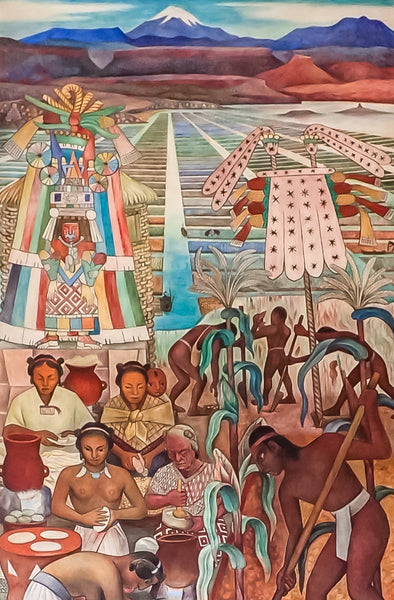
'Chinampas' or floating gardens were created for agriculture during the Mexica empire. An idealized view of the gardens as painted by Mexican muralist Diego Rivera in the Palacio Nacional in Mexico City.
Today the area is known as Xochimilco, where locals continue to cultivate and sell plants, produce, and flowers. Visitors can rent colorful 'trajineras' or gondola style boats to cruise the remnants of a vast water transit system built by the Aztecs. The atmosphere is festive with plenty of stops for food, drink, and plants.
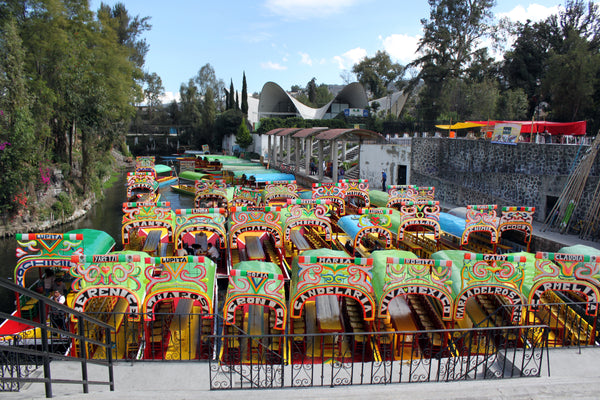
Colorful 'trajineras' cruise the canals once used by the Aztecs, photo by Anagoria at Wikimedia commons.
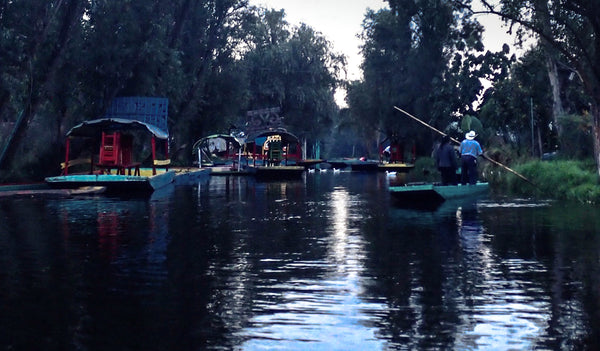
Cody, a local friend, and I arrived at Xochimilco near dusk, as vendors were closing and traveling home for the day.
When Spanish conqueror, Hernán Cortés, arrived on the Yucatan peninsula in March 1519, the Mexica empire was at its height. Hundreds of miles of roads traversed the countryside with relay runners reporting news daily to the 'tlatoani' or ruler in Tenochtitlan. The arrival of eleven floating mountains (ships) and over 500 men with strange beasts (horses) was reported immediately to Moctezuma II in his resplendent island palace. As Cortés made his way toward the magnificent capital city, the ruler and his nobles knew the Spaniards every move. However, due to the empire's unrestrained quest for land, resources, and blood to appease the gods, many of the natives were eager to assist Cortés and his men in defeating the great Aztec ruler and his empire. In over the course of a year including six months living inside Tenochtitlan, Hernán Cortés, his army, and over 100,000 locals defeated the Aztec empire through blockading food and water to the island, winning hard-fought battles on land and in the lake to the eventual triumph over the citizens of Tenochtitlan. On August 13, 1521, Tenochtitlan was claimed for the crown of Spain becoming officially known as Ciudad de México, Mexico City.
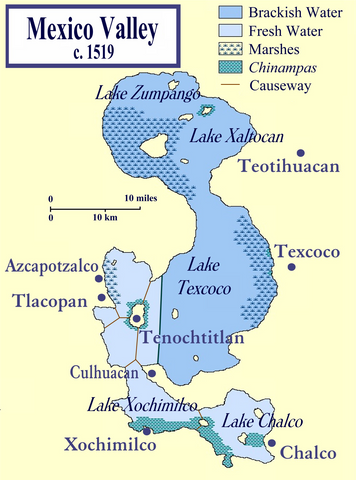
A map of the Valley of Mexico when the Spanish arrived. The greater metropolitan area of Mexico City with its 21 million people resides above the now drained lake beds. The city is currently sinking approximately 3 feet per year. Map provided by Madman2001 at Wikimedia commons
In Mexico City, a visit to the Museo Nacional de Antropología or National Museum of Anthropology is essential. The museum is located in Chapultepec Park, the Aztec term for grasshopper. The prosperous area is home to one of the largest urban parks in the western hemisphere and was once a native forest used by the early inhabitants of the Valley of Mexico. Inside the museum, a vast collection of ancient artifacts and pre-Columbian art are on display from the great empires of Mexico and Mesoamerica including the enormous 24 ton stone carving of the Aztec Calendar or "Stone of the Sun."

Carved from a single rock of basalt, the monolithic sculpture was buried by the Spanish conquerors and rediscovered in 1790 during repairs on the Mexico City Cathedral. Although archaeologists do not agree on the exact use, many believe it was used as a ceremonial ritual altar. In the center is a solar deity with a sacrificial knife tongue as clawed hands on either side hold human hearts. The quadrants and glyphs refer to solar eras of time and Mexica cosmology with Tenochtitlan as the center of the universe. Today the calendar stone image is a symbol of cultural identity, as is the Mexica legend of an eagle on a cactus holding a serpent that proudly flies on the Mexican Flag.
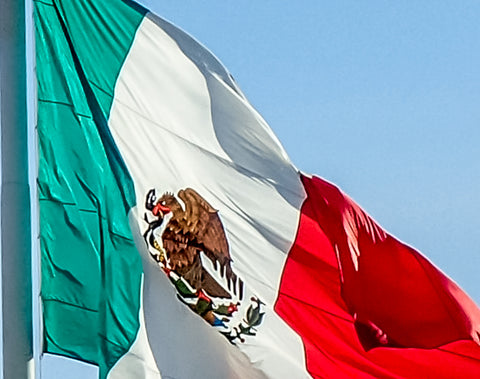
Bandera de México, The Mexican Flag
Mexico City is an ancient and modern marvel of art, architecture, and culture. The vibrant city is filled with welcoming, spirited people proud of their collective history. Everyone we met was enthusiastic to share their knowledge and helped direct our mission of discovering an ancient empire hidden among a modern bustling metropolis.
*The Botanical Journey is now partnered with Stay22 to provide you with easy access to lodging information at the best prices available for Hotels and Airbnb. We receive a small commission for booked reservations. Thank you for your support.


Leave a comment
Please note, comments must be approved before they are published